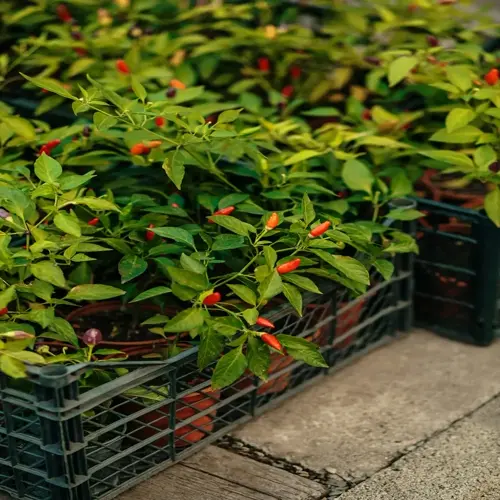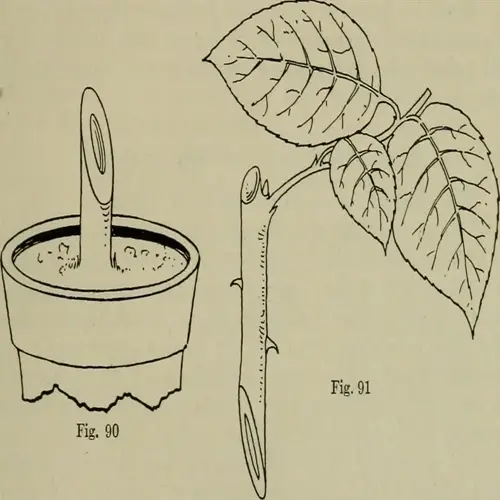How to Grow Spinach in Containers Successfully

Written by
Olivia Mitchell
Reviewed by
Prof. Charles Hartman, Ph.D.Find out how to grow spinach in containers using shallow 12-inch pots (with drainage holes).
Consider bolt-resistant varieties, such as Space or Regiment for continual harvesting in containers.
Use 70% potting mix + 30% compost for drainage and nutrient retention.
Plant seeds about ½ inch deep in the fall/spring and thin them to 4-6 inch spacing.
When harvesting, take the outer leaves at 3-4 inches and it will regrow, using a "cut-and-come-again" technique.
Consider companion planting with garlic and radishes as a natural means of pest control.
Article Navigation
Knowing how to grow spinach in a container allows you to harvest your own fresh greens full of vitamins A, C, K, and iron to help you maintain healthy bones and a strong immune system. Container gardening enables us to grow food even in small apartment spaces or urban yards.
Vegetables can typically be harvested in 25 to 50 days for fresh spinach leaves, faster than most vegetables. If you strategically plan and use rotational planting both indoors and outdoors, you can enjoy fresh harvests throughout the year. This provides you with fresh nutritional nourishment, straight from your home.
Overwintering Spinach
Overwintering spinach is most effective in USDA hardiness zones 3-6, where plants can stay frozen outside. Sow six to eight weeks before your area's average first frost date. This timing gives seedlings time to develop roots before they go dormant for the winter.
Utilize cold frames as unheated mini-greenhouses that hold heat near containers. Put them on south-facing walls to maximize solar exposure. These barriers help maintain temperatures 10-15°F higher than the outside air, allowing spinach to endure harsh winter weather.
During dormancy, you only need to water the plants once a month. Too much moisture will provoke root rot in cold ground. Test the soil dryness before watering. When plants begin to grow again in the spring, you can resume their regular watering schedule now that their winter dormancy is over.
Protection Methods
- Cold frames provide insulation against freezing temperatures while allowing sunlight penetration
- Frost cloth creates a protective barrier against wind and frost damage in exposed areas
- Position protection structures facing south to maximize winter sun exposure
- Ensure covers are removable for ventilation during warmer daytime temperatures
Water Management
- Dormant spinach requires minimal hydration - check soil moisture monthly
- Water only when soil feels dry 2 inches (5 cm) below surface during thaw periods
- Avoid watering when temperatures are below freezing to prevent ice damage
- Use room-temperature water to avoid shocking plant roots in cold conditions
Planting Schedule
- Time planting for 6-8 weeks before average first frost in your region
- This allows plants to establish roots before winter dormancy begins
- In mild climates (zones 7-9), plant in late fall for continuous harvest
- Record local frost dates using agricultural extension resources for accuracy
Temperature Monitoring
- Maintain soil temperatures above 20°F (-6°C) for spinach survival through winter
- Use soil thermometers to track root zone conditions under protection structures
- Add straw insulation around containers when temperatures drop below 10°F (-12°C)
- Prevent sudden temperature fluctuations that can damage cellular plant structures
Spring Transition
- Gradually remove protection as daytime temperatures consistently exceed 45°F (7°C)
- Begin regular watering schedule when new growth appears in early spring
- Apply diluted fish emulsion fertilizer to stimulate post-dormancy growth
- Harvest overwintered spinach before bolting occurs in late spring warmth
Companion Planting
Companion planting is a natural way for plants to help one another grow. Garlic emits a pungent smell that repels spider mites and aphids. At the same time, spinach serves as a living mulch and ground cover. Having ground cover helps minimize weeds and maintain consistent soil moisture.
Plant fast-growing radishes alongside spinach to maximize the use of space. The radishes proliferate with a 30-day maturation period, allowing you to free that space for the spinach to expand. You can maximize the garden space by staggering the two crops and harvesting them at different times.
Avoid planting potatoes near spinach containers. Both are heavy nitrogen feeders that compete aggressively, resulting in stunted growth. Corn and sunflowers also create excessive shade, blocking the sunlight spinach needs.
To create an attractive arrangement, pair a vibrant green spinach with bright marigold flowers. Their bright colors make for beautiful container displays, while marigolds also serve to deter soil nematodes. Trailing nasturtiums provide height and also attract pests away from the spinach leaves.
Beneficial Allies
- Garlic repels aphids and spider mites naturally with its strong scent compounds
- Lettuce shares similar moisture needs while providing shade to spinach roots
- Radishes mature quickly in 30 days, freeing space before spinach expands
- Marigolds deter nematodes in soil while adding visual appeal to containers
Plants to Avoid
- Potatoes compete aggressively for nitrogen and phosphorus nutrients in container soil
- Sunflowers create excessive shade blocking necessary sunlight for spinach growth
- Fennel releases root chemicals that inhibit spinach germination and development
- Corn depletes soil moisture rapidly requiring incompatible watering schedules
Space Optimization
- Plant quick-growing radishes around spinach perimeter for efficient space use
- Use vertical lettuce varieties to maximize light penetration to spinach below
- Interplant garlic cloves every 8 inches along container edges for protection
- Create tiered containers with spinach below and trailing nasturtiums above
Soil Synergy
- Beans fix nitrogen in soil through root nodules benefiting leafy greens
- Carrots break up soil compaction improving drainage for spinach roots
- Chamomile increases oil production in nearby spinach through root emissions
- Basil enhances flavor profile of spinach leaves when grown in proximity
Pest Control
- Nasturtiums attract aphids away from spinach acting as sacrificial plants
- Dill attracts parasitic wasps that control leaf-eating caterpillars naturally
- Chives repel Japanese beetles with sulfur compounds in their foliage
- Mint deters ants and flea beetles through strong aromatic oil production
Choosing Spinach Varieties
Choosing the correct spinach type plays a significant role in your container success. Smooth-leaf types like Space mature quickest, taking around 25-30 days, and have the tender, flat leaves you want for salads. Savoy types mature in approximately 35-40 days, featuring crinkled leaves that withstand heat and retain their integrity during cooking.
Consider using space-saving hybrid varieties. Both Regiment and Space are compact and grow vertically, saving space while producing an extremely high yield. Avoid [sprawling heirloom varieties] like Violets that will take a large, bulky pot unless you have excess space.
Bolt resistance is significant in warm climates. The American and Regiment varieties resist summer heat better, prolonging flowering. This helps to extend your harvest window when temperatures unexpectedly rise, protecting the investment you have made in your crop.
Enhance visual appeal with decorative types, such as Red Tabby. The bold red veins create a striking contrast with the greenery of spinach in combination with other plants in containers. The ornamental varieties successfully grow in pots, providing mildly flavored edible leaves.
Container and Soil Setup
Your spinach containers will benefit from a minimum dimension of 12 inches deep and 12 inches wide so that the roots can grow properly. Having a designated area allows the roots to grow out without being crowded, promoting healthy growth. A deep pot allows for soil to be sacrificed, while a shallow pot stunts growth and reduces your potential yield.
Be mindful of your container materials. Plastic pots retain moisture, reducing the need for frequent watering. Terracotta provides better air circulation, preventing root rot, but evaporates more quickly. Choose according to your climate and the frequency of watering you prefer for healthy plants.
To make a great soil mix, use a blend of 70% potting soil and 30% compost. This mix of ingredients provides the necessary nutrients to plants and maintains the optimal balance of drainage. Do not use garden soil as it compacts in containers, suffocating the roots and creating drainage issues.
Drainage holes are essential for spinach health; water will sit in the bottom of the pot and rot roots without drainage. Provide at least three 0.5-inch holes per square foot, more if possible. Elevate the container on pot feet to promote airflow and prevent water runoff after watering.
Container Selection
- Minimum size requirement: 12 inches (30 cm) deep x 12 inches (30 cm) wide per spinach plant
- Material options: lightweight plastic retains moisture; porous terracotta improves air circulation
- Drainage necessity: at least three 0.5 inch (1.25 cm) holes per square foot of container base
- Alternative containers: repurposed 5-gallon buckets with added drainage holes
Soil Composition
- Ideal blend: 70% potting soil provides structure; 30% compost adds nutrients
- pH requirements: maintain 6.0-7.0 range for optimal nutrient absorption
- Drainage enhancement: add perlite or vermiculite if soil compacts easily
- Nutrient boost: incorporate worm castings for slow-release nitrogen and minerals
Fertilization Strategy
- Initial feeding: mix slow-release organic granules into soil before planting
- Maintenance schedule: apply liquid fish emulsion every 3 weeks during growth
- Nitrogen focus: select fertilizers with higher first number (e.g., 5-3-3 NPK)
- Caution: avoid high-phosphorus formulas that accelerate bolting in spinach
Drainage Setup
- Hole placement: evenly distribute drainage holes across container bottom
- Prevent clogging: cover holes with landscape fabric or coffee filters before adding soil
- Elevation: place containers on pot feet or bricks to enable water runoff
- Monitoring: ensure water flows freely during initial watering test
Soil Preparation
- Moistening: pre-dampen soil mix 24 hours before planting for even hydration
- Layering: create 1-inch (2.5 cm) gravel base below soil in deep containers
- Aeration: fluff soil with hands before planting to prevent compaction
- Depth: fill to 1 inch (2.5 cm) below rim to prevent overflow during watering
Planting and Care Essentials
Spinach seeds should be planted 0.5 inches deep and spaced 2 inches apart. For rectangular containers, seed spacing should be 3-4 inches apart. Lightly cover the seeds with soil mix and gently firm the surface, assuring proper seed-to-soil contact for germination.
Thin seedlings when true leaves appear approximately 2-3 weeks after planting. Snip weaker seedlings at the soil level with scissors, leaving 4-6 inches between spinach seedlings. Do not pull seedlings, as it disturbs neighboring roots and reduces overall growth potential.
Water daily with light agitation until germination, then switch to deep watering whenever the top half-inch of soil is dry. Stick your finger down there to check moisture. Deep watering encourages roots to grow downward, resulting in stronger, drought-tolerant plants in the long run.
Use shade cloth when the temperatures surpass 80°F (27°C ) to keep any crops from bolting. Hang the fabric 12 inches above the containers to allow for airflow while minimizing heat stress. Remove the cloth in the cooler hours of the morning and evening for better exposure to light.
Seed Sowing
- Plant seeds 0.5 inches (1.25 cm) deep in moist soil for optimal germination
- Space seeds 2 inches (5 cm) apart to minimize thinning requirements later
- Pre-chill seeds in refrigerator for 5 days before planting to speed germination
- Cover lightly with soil mix and gently pat down for soil-seed contact
Water Management
- Mist soil surface daily until seeds germinate (5-14 days depending on temperature)
- Water deeply when top 0.5 inch (1.25 cm) of soil feels dry to the touch
- Use watering can with rose attachment for gentle, even distribution
- Add mulch layer to retain moisture and reduce watering frequency by 30%
Thinning and Spacing
- Thin seedlings to 4-6 inches (10-15 cm) apart when first true leaves appear
- Use scissors to cut unwanted seedlings at soil level to avoid root disturbance
- Keep strongest seedlings showing deep green color and vigorous growth
- Use thinned seedlings as microgreens in salads for zero waste
Light and Temperature
- Provide 4-6 hours of direct sunlight daily for optimal leaf production
- Use 40% shade cloth when temperatures exceed 80°F (27°C) to prevent bolting
- Rotate containers weekly for even light exposure on all plants
- Move containers to afternoon shade during summer heat waves
Harvest Technique
- Begin harvesting outer leaves when they reach 3-4 inches (7-10 cm) long
- Use clean scissors to cut leaves 0.5 inch (1.25 cm) above soil level
- Harvest in morning when leaves are crisp and sugar content is highest
- Never remove more than 30% of leaves at once to maintain plant health
5 Common Myths
To grow spinach correctly, you'll need a container with 18 inches of deep soil for growth of the plant's root system.
The roots of spinach grow shallow, therefore containers of 6-8 inches are also suitable. The roots can extract nutrients sensibly close to the soil surface without deep soil penetration. Since spinach is grown in a container, a limited root zone makes it more concentrated on leafy growth than on developing a long root system.
Many gardeners mistakenly believe container-grown spinach produces less flavorful leaves than ground-grown varieties.
Container spinach often develops superior flavor due to controlled soil conditions. Precise moisture management prevents dilution of flavor compounds while optimized fertilization enhances sugar content. Taste comparisons consistently rate container-grown spinach sweeter than field-grown counterparts.
Spinach can only be cultivated in cool spring and fall seasons.
Today, modern varietals and reflective containers give the option of growing spinach throughout the year. During the summer months, growing spinach with shade techniques works very well; during the winter, spinach is grown under protection. Practicing succession planting every three weeks allows for a continual harvest in all seasons.
One common misconception about spinach seeds is that they need to be soaked overnight before planting to ensure germination.
To plant the seeds correctly, they should be placed in soil approximately ½ inch or 1.25 cm deep in regularly moist soil at a temperature range of 45-75 degrees F (7-24 degrees C). Instead of soaking, exposing spinach seeds to cool conditions by chilling the seeds at 40 degrees Fahrenheit (4 degrees centigrade) for 5 days is more effective at improving germination time. Soaking seeds under cooler temperatures for this period may cause seeds to rot.
After the first harvest, spinach plants die and do not produce new leaves.
However, the cut and come again technique uses that natural ability to regenerate that plants have. If outer leaves are cut to 1/2 inch (1.25 cm) above the crown of the plant, it will produce new regrowth for 3-5 harvests over the next 8 weeks. This technique keeps the plant healthy while allowing for perpetual harvest.
Conclusion
Container gardening produces fresh spinach without the use of garden space. Your balcony, patio, or windowsill can be your very own area to make your own food. This allows nutritious leafy greens to be available even in urban areas where ground space is scarce or nonexistent.
Utilize year-round harvests with overwintering methods and summer shading methods. Rotate containers from indoors to outdoors throughout the year. Regular planting every couple of weeks ensures a constant supply of spinach, regardless of the weather conditions outside.
Simple. Start with 1 container to build confidence, then increase. For your first attempt, start with a small growth type, such as Regal spinach. Working with just one pot can eventually encourage you to grow at a manageable pace without feeling too rushed.
In just 30 days from planting, you can harvest your very own vitamin-rich, nutrient-dense meal. Spinach grown at home has more nutrients than store-bought spinach. Each time you harvest fresh spinach, you automatically have health-promoting antioxidants and minerals right in your hands.
External Sources
Frequently Asked Questions
How deep should a container be to grow spinach?
Spinach thrives in containers as shallow as 6-8 inches (15-20 cm) since it develops shallow roots. Deeper pots beyond 12 inches waste soil without benefits. Ensure adequate drainage holes to prevent waterlogging and root rot in compact spaces.
Can spinach regrow after harvesting?
Yes, spinach regenerates using its basal meristem tissue when harvested correctly:
- Cut outer leaves 0.5 inch (1.25 cm) above the crown
- Never remove more than 30% of leaves at once
- Plants produce 3-5 harvests over 8 weeks
What are ideal companion plants for container spinach?
Strategic pairings enhance growth and pest resistance:
- Garlic repels aphids naturally without chemicals
- Radishes mature quickly before spinach expands
- Avoid potatoes and corn which compete for nutrients
Is spinach suitable for fall planting?
Fall is optimal for spinach due to cooler temperatures. Plant seeds 6-8 weeks before first frost using cold frames for insulation. Overwintering varieties survive freezing temperatures with proper protection techniques.
What soil mix works best in containers?
Use a blend of 70% potting soil and 30% compost for balanced drainage and nutrition. Incorporate perlite if soil compacts easily, and maintain pH between 6.0-7.0 for optimal nutrient absorption.
How much sunlight does container spinach need?
Spinach requires 4-6 hours of direct sunlight daily. Use shade cloth when temperatures exceed 80°F (27°C) to prevent bolting. Rotate containers weekly for even light distribution across all plants.
Can you grow spinach year-round in containers?
Yes, with season-specific strategies:
- Summer: Shade cloth and frequent watering
- Winter: Cold frames or indoor LED setups
- Succession planting every 3 weeks maintains continuous harvests
What are common spinach growing myths?
Debunked misconceptions include:
- Deep containers aren't necessary - shallow roots thrive in 8-inch pots
- Pre-soaking seeds offers no benefits over proper planting depth
- Container spinach often tastes sweeter than ground-grown varieties
How do you prevent bolting in spinach?
Bolting occurs when plants flower prematurely due to stress. Maintain soil moisture consistently, use shade during heatwaves, and select bolt-resistant varieties like Regiment or America for reliable harvests.
What fertilizer works best for container spinach?
Use nitrogen-rich formulas like fish emulsion every 3 weeks. Avoid high-phosphorus options which trigger bolting. Slow-release granules mixed into soil at planting provide steady nutrition without burning roots.

